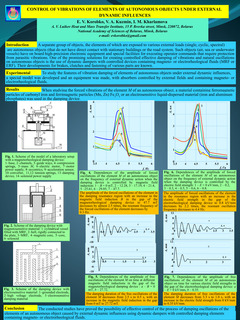Control of vibrations of elements of autonomous objects under external dynamic influences
ID:65
Submission ID:6 View Protection:ATTENDEE
Updated Time:2023-06-06 15:24:48
Hits:828
Poster Presentation
Abstract
A separate group of objects, the elements of which are exposed to various external loads (single, cyclic, spectral), are autonomous objects that do not have direct contact with stationary buildings or the road system. Such objects (air, sea or underwater vessels) have on board high-precision electronic equipment and special facilities for executing operator commands that require protection from parasitic vibrations.
One of the promising solutions for creating controlled effective damping of vibrations and natural oscillations on autonomous objects is the use of dynamic dampers with controlled devices containing magneto- or electrorheological fluids (MRF or ERF). Their developments for brakes, clutches and fastening of various parts are known.
To study the features of vibration damping of elements of autonomous objects under external dynamic influences, a special model was developed and an equipment was made, with absorbers controlled by external fields and containing magneto- or electrorheological fluids.
The equipment allows to fix both natural and forced vibrations of the element M (weight 2 kg) of an autonomous object under various frequency modes of external force (dynamic, single) both in electric and magnetic fields in the frequency range of 3.5–6.0 Hz.
When studying the forced vibrations of the element M of an autonomous object, a material containing ferromagnetic particles of carbonyl iron and ferrimagnetic particles (Mn, Zn) Fe2O3 or an electrosensitive liquid-dispersed material (iron and aluminum phosphates) was used in the damping device.
The research results showed that the amplitude of the forced oscillations of the element M in the resonance region with an increase in the magnetic field induction B in the gap of the magnetorheological damping device decreases by almost 2.5 times, and the resonant frequency of the forced oscillations decreases by 0.3 Hz.
In a damping device with an electrosensitive liquid-dispersed material, with an increase in the electric field strength, the amplitude of forced oscillations M in the resonance region decreases by 2.2 times, the resonant oscillation frequency decreases by 0.3 Hz.
It should be noted that during forced oscillations, with an increase in the strength of the electric or magnetic fields, a hard grip of the M element and the damping device occurs, which makes it possible to work in the contact mode with the shell of an autonomous object.
The damping duration (t) of the natural oscillations of the M element decreases from 3.3 s to 0.5 s. The logarithmic damping decrement increased from 0.171 to 1.0 as the fields increased.
The studies have proved the possibility of effective control of the process of damping oscillations of the elements of an autonomous object caused by external dynamic influences using dynamic dampers with controlled damping elements containing magneto- or electrorheological fluids.
A separate group of objects, the elements of which are exposed to various external loads (single, cyclic, spectral), are autonomous objects that do not have direct contact with stationary buildings or the road system. Such objects (air, sea or underwater vessels) have on board high-precision electronic equipment and special facilities for executing operator commands that require protection from parasitic vibrations.
One of the promising solutions for creating controlled effective damping of vibrations and natural oscillations on autonomous objects is the use of dynamic dampers with controlled devices containing magneto- or electrorheological fluids (MRF or ERF). Their developments for brakes, clutches and fastening of various parts are known.
To study the features of vibration damping of elements of autonomous objects under external dynamic influences, a special model was developed and an equipment was made, with absorbers controlled by external fields and containing magneto- or electrorheological fluids.
The equipment allows to fix both natural and forced vibrations of the element M (weight 2 kg) of an autonomous object under various frequency modes of external force (dynamic, single) both in electric and magnetic fields in the frequency range of 3.5–6.0 Hz.
When studying the forced vibrations of the element M of an autonomous object, a material containing ferromagnetic particles of carbonyl iron and ferrimagnetic particles (Mn, Zn) Fe2O3 or an electrosensitive liquid-dispersed material (iron and aluminum phosphates) was used in the damping device.
The research results showed that the amplitude of the forced oscillations of the element M in the resonance region with an increase in the magnetic field induction B in the gap of the magnetorheological damping device decreases by almost 2.5 times, and the resonant frequency of the forced oscillations decreases by 0.3 Hz.
In a damping device with an electrosensitive liquid-dispersed material, with an increase in the electric field strength, the amplitude of forced oscillations M in the resonance region decreases by 2.2 times, the resonant oscillation frequency decreases by 0.3 Hz.
It should be noted that during forced oscillations, with an increase in the strength of the electric or magnetic fields, a hard grip of the M element and the damping device occurs, which makes it possible to work in the contact mode with the shell of an autonomous object.
The damping duration (t) of the natural oscillations of the M element decreases from 3.3 s to 0.5 s. The logarithmic damping decrement increased from 0.171 to 1.0 as the fields increased.
The studies have proved the possibility of effective control of the process of damping oscillations of the elements of an autonomous object caused by external dynamic influences using dynamic dampers with controlled damping elements containing magneto- or electrorheological fluids.
Keywords
Autonomous object;vibrational system;damping device;electric and magnetic fields;magneto- and electrorheological fluids
Submission Author
Evguenia Korobko
A. V. Luikov Heat and Mass Transfer Institute of NAS of Belarus
Vladimir Kuzmin
A. V. Luikov Heat and Mass Transfer Institute of NAS of Belarus
Inga Kharlamova
A. V. Luikov Heat and Mass Transfer Institute of NAS of Belarus


Comment submit